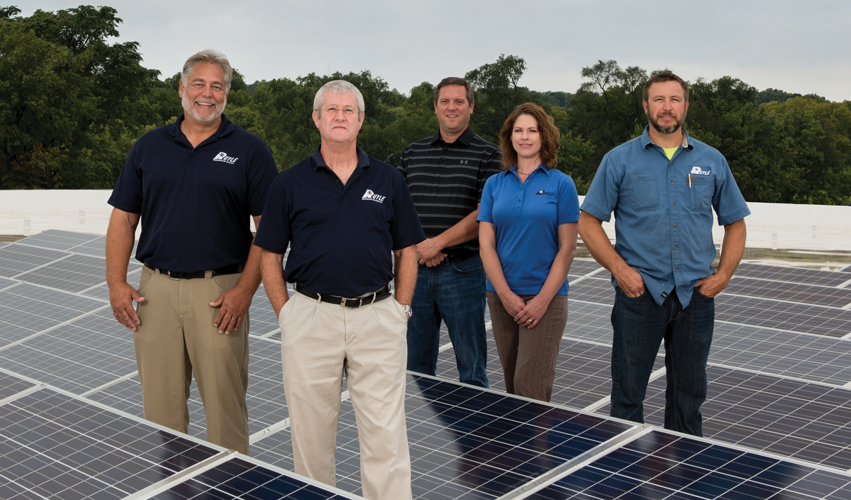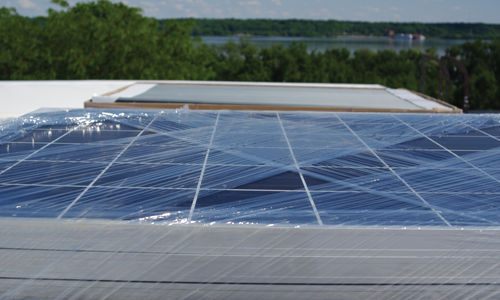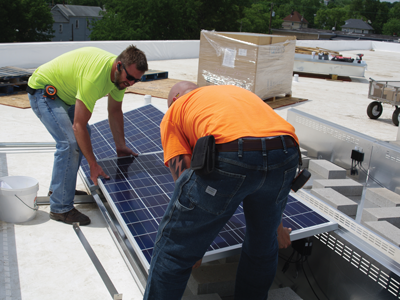
Pairing energy efficiency with a solar PV project can bring a host of benefits to any business.
There’s a reason the U.S. Department of Energy put its Office of Energy Efficiency and Renewable Energy under one roof—because they belong together. Energy efficiency and renewable energy generation should be paired together like peanut butter and jelly, crackers and cheese, white wine and pasta.
As the price of solar photovoltaic (PV) modules declines and the tax incentives for renewables remain stable, installing solar has become more and more popular with the commercial and industrial sectors. The reason? It’s a good investment with short returns and long-term benefits for the business.
Charting the Course
Installing a solar array is a visual commitment to controlling utility costs and impacting carbon emissions—but it’s not the best way to begin that commitment. Solar arrays are sized based on the energy consumption of a facility, the amount of space available for an array, and the size of investment an owner is willing to make. In our experience, most commercial and industrial facilities don’t have enough space for an array sized to offset all energy consumption—to become “net-zero.” Think of it this way: the energy used by a business is the size of a football field, but the available space for solar is the size of a tennis court.
The best way to bring this dilemma into balance is through energy efficiency. Energy efficiency reduces the amount of energy consumed in a building (shrinking the football field) and reduces the size of the solar PV system needed to make an impactful difference in the utility bill (a perfect-sized tennis court).
Understanding this, many business owners, facility directors and maintenance staff will implement the “low-hanging fruit” of energy efficiency, such as lighting. After lighting, it becomes harder to know what to tackle next. The question becomes: What’s using the most energy now? My HVAC, my process equipment, the behavior of my employees? How does that get calculated, and who has time to do it?

Assessing Performance
The first step to answering those questions is an investment-grade energy assessment of the building(s) and process(es), which can also be referred to as an ASHRAE Level-2 Energy Assessment (ASHRAE: American Society of Heating, Refrigerating and Air Conditioning Engineers). The building should be analyzed for items like insulation, envelope tightness, site performance (such as solar gain through windows) and previous remodels that may have changed its heating and cooling requirements. The process can include an industrial process within the building, or the way people use the building. Maybe it’s a mixed-use building or an office building. Maybe it’s an elder care facility or a hospital. What happens inside is the process.
This type of assessment requires hiring a contractor or consulting firm to be in the facility and analyze the utility bills; heating, cooling and ventilation loads; data loggers or trends from automation systems; and the processes to determine the largest consumer of energy for the business. This information will result in an overall analysis of how the facility and its processes can be configured for maximum energy efficiency. From this report, an owner, facility director or maintenance manager will know how well the building is performing (the benchmark), what steps to take next, and just how simple or complex they might be. The value of this information far outweighs the cost associated with it. Just as a marketing firm can provide vital information to increase business sales and revenue, an energy assessment can provide vital information to reduce utility bills and increase revenue.
An Array of Resources
Of course, an investment-grade energy assessment is not the only way to implement energy efficiency. Just about every professional association, from healthcare to dry cleaning, has some type of guide or checklist available online for its members to learn from and implement. In addition, the Department of Energy’s Office of Energy Efficiency and Renewable Energy has a vast amount of information on residential, commercial, industrial and transportation-sector energy efficiency, as well as several online calculators and modeling software available for public use (energy.gov/eere/office-energy-efficiency-renewable-energy). It is currently promoting an initiative called Zero Energy Buildings, or ZEBs, which specifically targets energy efficiency paired with renewable installations.
Another resource is the U.S. Environmental Protection Agency (EPA) Energy Star website (energystar.gov). Again, there are so many resources available that you could spend weeks researching information and get utterly lost in it all. Perhaps the most valuable of the EPA resources is the web-based program Portfolio Manager (portfoliomanager.energystar.gov). Free to the public, Portfolio Manager provides a comparison analysis of energy used in a building to that of other buildings of the same type (retail, education, worship, municipal, etc.).

With a minimal amount of information, Portfolio Manager provides a number—a grade between one and 100—to assist in understanding whether a building is energy-efficient or not. If it scores a one, the building is on the one-yard line of the football field, meaning it is an energy hog and there are plenty of yards and plays available for improvement. If the building scores an 80, it only has 20 yards left to go—a pretty energy-efficient building. As a result, the business’ goal of reduced operating costs will lead it to the next step: solar!
A Long-Term Investment
The benefits of implementing energy efficiency in combination with solar or other renewables are many. There are several studies coming out now about “non-energy benefits,” which focus on the value of occupant comfort and employee productivity. It is much harder to put a price to these non-energy benefits, but that does not mean they aren’t impactful to the bottom line. Those in the energy efficiency sector are trying to put a value to each non-energy benefit, hence the many studies being done. Non-energy benefits can include reduced maintenance on equipment, reduction in errors or scrap rates, increased facility and asset values, enhanced workplace health and safety, increased employee applicant pool, risk avoidance of energy price fluctuations, reduced equipment failures, and on and on.
Utilizing solar PV is a great step in reducing operating costs, making the football field as small as possible. Solar PV is a smart investment for any business. The first step in making the most of that investment should be making the facility as energy-efficient as possible. Pairing energy efficiency with a solar PV project will enable the business to enjoy all of the benefits of moving towards a sustainable and cost-effective operation. iBi
Kiersten Sheets is a LEED Green Associate and Energy Solutions Implementer with Ruyle Mechanical Services. Don Howerter is a LEED Accredited Professional O&M (operations and maintenance) and Energy Services Project Manager at Ruyle Mechanical Services. To learn more, visit ruylecorp.com.

